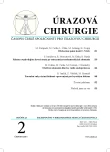Factors infuencing blood loss after osteosynthesis of trochanteric fractures
Authors:
Stanislava Imrichová; Radoslav Morochovič; Miroslav Kitka; Rastislav Burda
Authors‘ workplace:
Department of Traumatology, Faculty of Medicine, University of P. J. Šafárik and L. Pasteur University Hospital in Košice
; Klinika úrazovej chirurgie LF UPJŠ a UNLP Košice, Slovenská republika
Published in:
Úraz chir. 23., 2015, č.2
Overview
Introduction:
Using closed suction drainage after hip fracture surgery is still controversial. The aim of its use is the reduction of postoperative wound haematoma formation, but on the other hand its use increases morbidity due to higher risk of wound infection. It would be advisable to use suction drains in patinets with higher risk of postoperative wound haematoma formation.
Objective:
To evaluate the volume of postoperatively drained blood in group of older pacients whose trochanteric fracture was stabilized with dynamic hip screw (DHS). Secondary objective was comparing drained blood volumes according to selected risk factors.
Methods:
A prospective observational study of 202 pacients in the age of 65 years and older fixed with DHS for trochanteric fracture between 2008 - 2012. The volume of blood loss collected into the closed suction drainage (Redon drain) was measured within 48 hours after surgery. Evaluated risk factors were: preinjury anti-platelet and/or anti-coagulant medication, body mass index (BMI), American Society of Anesthesiologists classification (ASA), type of fracture, type of ane-sthesia, surgeon´s experience with surgical technique and size of DHS implant.
Results:
The mean volume of drained blood was 130,7 ml (SD 94,7). Mean blood loss was greater in patients operated by less experienced surgeons (mean 158,14 ml) in comparison to experienced ones (123,3 ml, p = 0,02) and treated with longer DHS plate (four or five - hole plate) in comparison to shorter (three - hole plate) (148,0 vs 102,7 ml, p <0,01). Preinjury anti-platelet and anti-coagulant medication, ASA score, BMI, type of anesthesia and type of fracture had no influence on vo-lume of postoperatively drained blood.
Conclusion:
Greater postoperative blood loss can be expected in the case of using longer DHS plates and in surgery performed by less experienced surgeon.
Key words:
Trochanteric Fractures, Dynamic hip screw, Postoperative blood loss, Postoperative suction drainage.
Sources
1. ACUS, RW, 3RD, CLARK, JM., GRADISAR, IA, JR. et al. The use of postoperative suction drainage in total hip arthroplasty. Orthopedics. 1992, 15, 1325–1328.
2. BARTONÍČEK, J., DOUŠA, P., SKÁLA-ROSENBAUM, J. et al. Trochanterické zlomeniny - Souborný referát. Úraz chir. 2002, 10, 13-24.
3. CLIFTON, R., HALEEM, S., MCKEE, A., PARKER et al. Closed suction surgical wound drainage after hip fracture surgery: a systematic review and meta-analysis of randomised controlled trials. Int Orthop. 2008, 32, 723-727.
4. COBB, J. P. Why use drains? J Bone Joint Surg Br. 1990, 72, 993-995.
5. COLLINGE, CA., KELLY, KC., LITTLE, B. et al. The effects of clopidogrel (Plavix) and other oral anticoagulants on early hip fracture surgery. J Orthop Trauma. 2012, 26, 568-573.
6. CHASSOT, PG., DELABAYS, A., SPAHN, DR. Perioperative use of anti-platelet drugs. Best Pract Res Clin Anaesthesiol. 2007, 21, 241–256.
7. CHECHIK, O., THEIN, R., FICHMAN, G. et al. The effect of clopidogrel and aspirin on blood loss in hip fracture surgery. Injury. 2011, 42, 1277–1282.
8. KUMAR, S., PENEMATSA, S., PAREKH, S. Are drains required following a routine primary total joint arthroplasty? Int Orthop. 2007, 31, 593–596.
9. LEANDRO-MERHI, V. A., DE AQUINO, J. L. Determinants of malnutri-tion and post-operative complications in hospitalized surgical patients. J Health Popul Nutr. 2014, 32, 400–410.
10. MATHUS-VLIEGEN, E. M. Old age, malnutrition, and pressure sores: an ill-fated alliance. J Gerontol A Biol Sci Med Sci. 2004, 59, 355–360.
11. MAURER, SG., CHEN, AL., HIEBERT, R. et al. Comparison of outcomes of using spinal versus general anesthesia in total hip arthroplasty. Am J Orthop (Belle Mead NJ). 2007, 36, E101–106.
12. MODIG, J. Regional anaesthesia and blood loss. Acta Anaesthesiol Scand Suppl. 1988, 89, 44–48.
13. MORLEY, JE. Anorexia and weight loss in older persons. J Gerontol A Biol Sci Med Sci. 2003, 58, 131–137.
14. OPPERER, M., DANNINGER, T., STUNDNER, O. et al. Perioperative outcomes and type of anesthesia in hip surgical patients: An evidence based review. World J Orthop. 2014, 5, 336–343.
15. ORTHOPAEDIC TRAUMA ASSOCIATION COMMITEE FOR CODING AND CLASSIFICATION. Fracture and dislocation compendium. J Orthop Trauma. 1996, 10 Suppl 1, v-ix, 1–154.
16. PARKER, MJ., LIVINGSTONE, V., CLIFTON, R. et al. Closed suction surgical wound drainage after orthopaedic surgery. Cochrane Database Syst Rev. 2007, 3, CD001825.
17. RASHID, RH., SHAH, AA., SHAKOOR, A. et al. Hip fracture surgery: does type of anesthesia matter? Biomed Res Int. 2013, 25, 23–56.
18. ROSE, B., SINDALI, K., SOUEID, H. et al. The effect of the grade of surgeon on blood loss in fractured neck-of-femur surgery. Eur J Orthop Surg Traumatol. 2013, 23, 449–456.
19. ŠTVRTINOVÁ, V. et al. Venózny tromboembolizmus, prevencia, diagnostika, liečba. 2. vyd. Bratislava: Herba, 2009, 240 s. ISBN 978-80-89171-63-7.
20. TJEENK, RM., PEETERS, MP., VAN DEN ENDE, E. et al. Wound drainage versus non-drainage for proximal femoral fractures. A prospective randomised study. Injury. 2005, 36, 100–104.
21. TOPINKOVA, E. Aging, disability and frailty. Ann Nutr Metab. 2008, 52 Suppl 1, 6–11.
22. VARLEY, GW., MILNER, SA. Wound drains in proximal femoral fracture surgery: a randomized prospective trial of 177 patients. J R Coll Surg Edinb. 1995, 40, 416–418.
23. VOLKERT, D., BERNER, YN., BERRY, E. et al. Guidelines on Enteral Nutri-tion: Geriatrics. Clin Nutr. 2006, 25, 330–360.
24. WORDSWORTH, DR., HALSEY, T., GRIFFITHS, R. et al. Clopidogrel has no effect on mortality from hip fracture. Injury. 2013, 44, 743–746.
Labels
Surgery Traumatology Trauma surgeryArticle was published in
Trauma Surgery

2015 Issue 2
Most read in this issue
- Treatment of the radial head fractures by endoprothesis
- Nailing of the calcaneal bone C-NAIL
- Injury of the hand with high pressure injection of heterogeneous subtances
- Factors infuencing blood loss after osteosynthesis of trochanteric fractures
